Scottish farm business income: annual estimates 2011-2012
Estimates of Total Income from Farming for 2011, inital estimates for 2012 and Farm Business Income estimates for 2011-12. For the most recent data, visit the Scottish farm business income (FBI) collection page below.
This document is part of a collection
3. Commentary : Total Income from Farming (TIFF)
3.1 Overview of TIFF 2011 and 2012
Chart 2 gives a summary of the make-up of outputs and inputs. In both years gross outputs were worth roughly £2.8 billion, subsidies £0.6 billion, and total costs £2.7 billion. The slight differences in these figures between 2011 and 2012 give overall TIFF estimates of £746 million and £635 million respectively. The data show that the profitability of the agricultural sector is heavily dependent upon subsidies. However it should also be noted that agriculture is the first stage in producing output for additional processing in downstream sectors (for example abattoirs and meat processing, dairy products and the beer and whisky industries).
A table showing the detailed list of components of TIFF is provided in section7.1 with data from 2003 to 2012.
Chart 2: Make-up of Agricultural Accounts, 2011 and 2012
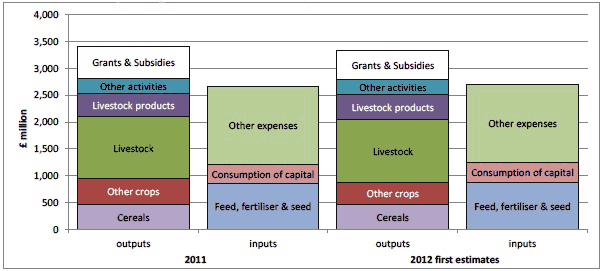
3.2 Long term trends
In real terms (once inflation has been accounted for), high inflation in the mid-1970s resulted in a large fall in TIFF. It then almost trebled between 1990 and 1995 before falling from 1995 to 1998 primarily due to a strong pound, weak world commodity prices and the impact of BSE. The outbreak of Foot and Mouth Disease in 2001 had little impact on TIFF. The real terms value then more than doubled between 1998 and 2012, though fluctuating every few years.
Chart 3: Trends in Total Income from Farming (TIFF), 1973 to 2012
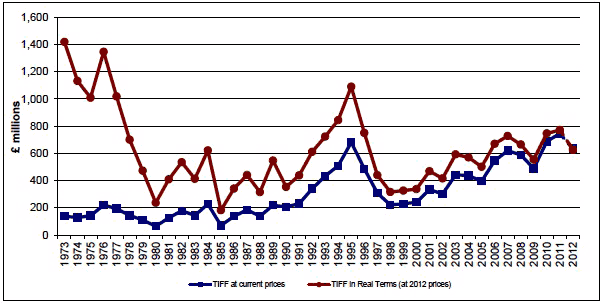
3.3 Overview of TIFF trends between 2010 and 2011 and between 2011 and 2012
Most of the information needed to calculate 2011 TIFF are now available, though a small number of further updates will be made to the final figures published next year.
Chart 4 : TIFF Changes from 2010 to 2011 (£millions)
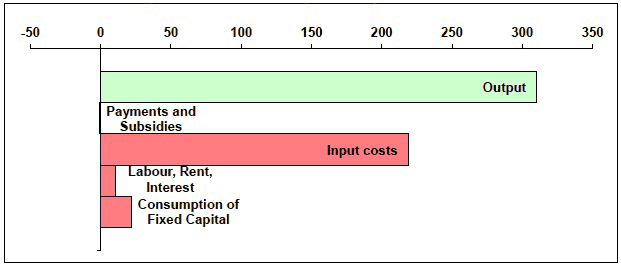
As initially estimated last year, the value of outputs and costs both rose considerably.
The TIFF estimates for 2012 are provisional, and are based on information that is available towards the end of 2012. A more complete position relating to some components (particularly costs) is not available until later in the year, therefore the 2012 figures must be treated as initial estimates.
Chart 5 : TIFF Changes from 2011 to 2012 (£millions)
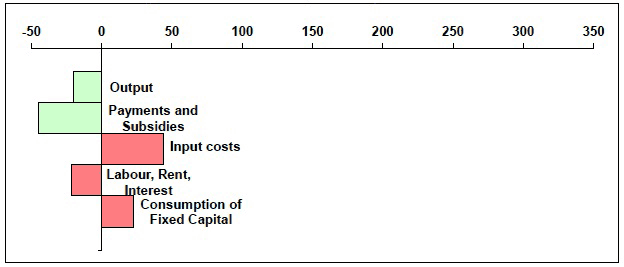
In 2012, the value of Outputs is estimated to have fallen by £20 million (one per cent), whilst the value of de-coupled Payments and Subsidies has fallen by £45 million (eight per cent). The value of Input Costs has risen by £44 million (two per cent), there has been an increase in the Consumption of Fixed Capital of £23 million (six per cent), but Other Costs to farmers (labour, rent and interest) have fallen by an estimated £21 million (five per cent). These produce an overall reduction in Total Income from Farming of £111 million (15 per cent, or 19 per cent taking into account inflation).
The underlying details of this, focusing on the main changes between 2010 and 2011 and between 2011 and 2012, are presented below.
3.4 Outputs from Scottish farms
Gross output increased by £310 million (12 per cent) in 2011, but fell an estimated £20million (one per cent) in 2012. In 2011 there were large increases for most sectors, particularly cereals, finished cattle, and milk and milk products.
Chart 6: Main Changes in Output Values from 2010 to 2011 (£ million)
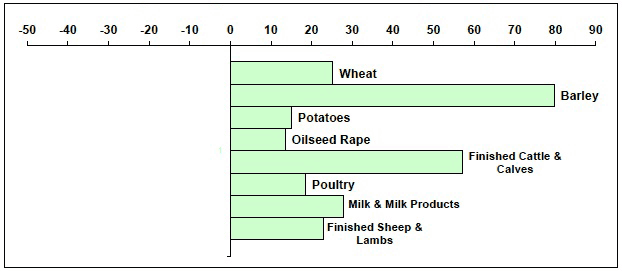
Chart 7: Main Changes in Output Values from 2011 to 2012 (£ million)
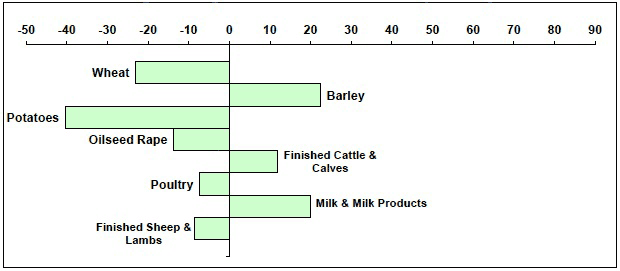
Estimates suggest that output in 2012 has increased in some areas but has decreased in others. The value of barley has risen £22 million (eight per cent), as higher prices were accompanied by an increase in the area harvested, though offset by 11 per cent lower yields. There was also an increase in the value of oats, though this is a smaller sector. The dairy sector has benefited from an estimated two per cent increase in volume of milk and four per cent higher prices, while finished cattle and calves has benefited from an average ten per cent increase in prices.
The value of potatoes is estimated to have fallen by £40 million (20 per cent), driven mainly by lower yields. The value of wheat has also fallen £23 million due to a 13 per cent reduction in area grown, together with a 19 per cent fall in yield, with oilseed rape also down £14 million. Finished sheep output has fallen by an estimated £8 million (four per cent) due to lower prices. Poultry output has fallen by an estimated £7million (seven per cent) due to a reduction in volume of meat production offset by higher prices.
3.5 Input costs faced by Scottish farmers
Input costs increased in 2011 by £219 million (13 per cent), with increases in costs for feeding stuffs, fertilisers & lime and fuel & oil being the main contributing factors. There was a large increase in the cost of feedstuffs of £66 million (13 per cent), with high prices driving an increase in the costs of feed for cattle, sheep and poultry in particular. The cost to farmers for fertilisers and lime increased substantially in 2011 by £42 million (24per cent). The average price of red diesel rose in 2011 meaning the value of fuel and oil used in 2011 rose £27 million (24 per cent).
Chart 8: Main Changes in Input Values from 2010 to 2011 (£ million)
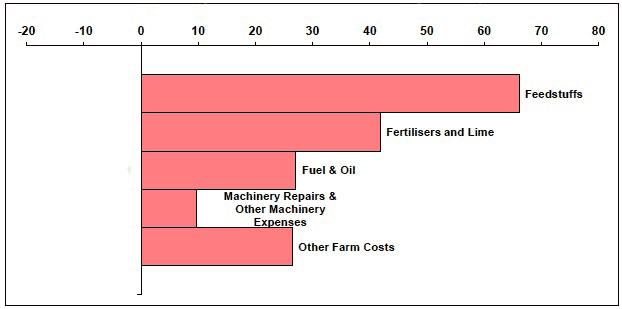
Chart 9: Main Changes in Input Values from 2011 to 2012 (£ million)
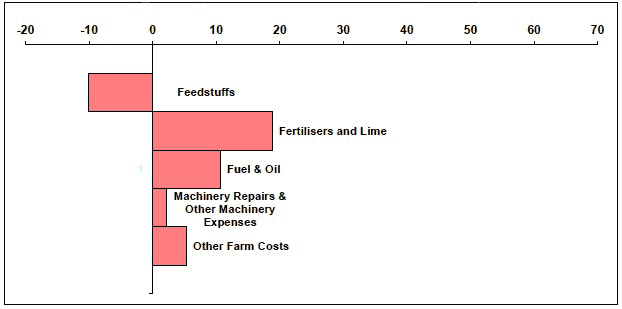
The estimated costs for 2012 are very dependent upon data not available until later in 2013, but the above chart is based on projections and using some information about UK price increases.
Gross input costs are projected to have increased in 2012 by £44 million (two per cent), with increase in costs for fertilisers & lime and fuel & oil being the main contributing factors. The estimated fall in the cost of feedstuffs is mainly due to a projected fall in poultry numbers.
3.6 Other costs faced by Scottish farmers
Hired labour costs rose £12 million (three per cent) in 2011 but fell by an estimated £23 million (seven per cent) in 2012. The fall in 2012 was due to a reduction in the cost of casual workers. The total cost of borrowing (combining Interest and the cost of financial services referred to as Financial Intermediation Services Indirectly Measured) increased by £2 million (three per cent) in 2011 and by £4 million (six per cent) in 2012. While average interest rates were stable, there was a slight increase in the overall level of borrowing. The net cost of rent fell ten per cent in 2011 to £15 million and a further six per cent in 2012 to £14 million, mainly due to a reduction in rented area.
3.7 Total payments and subsidies[4]
The value of farm payments and subsidies remained reasonably unchanged at £602 million in 2011, but fell by £45 million (eight per cent) to £557 million in 2012 due to changes in the euro exchange rate. Other changes in 2012 saw a tailing off in payments under the land management contract menu and rural stewardship schemes, as well as increases under rural priorities and land managers options. This partly reflects the operational transition between the old and new Rural Development schemes.
3.8 Revisions to previous TIFF estimates
Values for many of the datasets used in TIFF do not become available until later in the year. This means that the data published here for 2012 are often only a first estimate, with revised data being published next year. For the same reason this publication contains updated data for 2011.
A wide-ranging review of TIFF methodology during 2012 also resulted in several sets of data within TIFF being revised. Methodology changes were necessary due to some data no longer being available, improved data sources being identified, and improvements in estimations and modelling. Further methodological and data changes are likely next year. A document explaining all revisions to previously published TIFF estimates is available online at the following link
www.scotland.gov.uk/tiffrevisions2012
For the most recent years, TIFF has been revised up £116 million (20 per cent) in 2010 and £150 million (25 per cent ) in 2011. The revised trend in TIFF between 2010 and 2011 shows an increase of £58 million (eight per cent) before inflation, a more positive trend than that published in January 2012 (which initially estimated a four per cent increase).
3.9 Land prices
The calculation of TIFF does not currently account for changes in the value of land, although the European Commission state that this should be incorporated into calculations in the near future. Any increase in land value would effectively amount to income from farming, in the same way that we currently account for changes in the value of stock. Data from commercial organisations suggest that arable land prices may have seen a slight fall in 2011, with pasture prices remaining stable.
Contact
Email: agric.stats@gov.scot
There is a problem
Thanks for your feedback